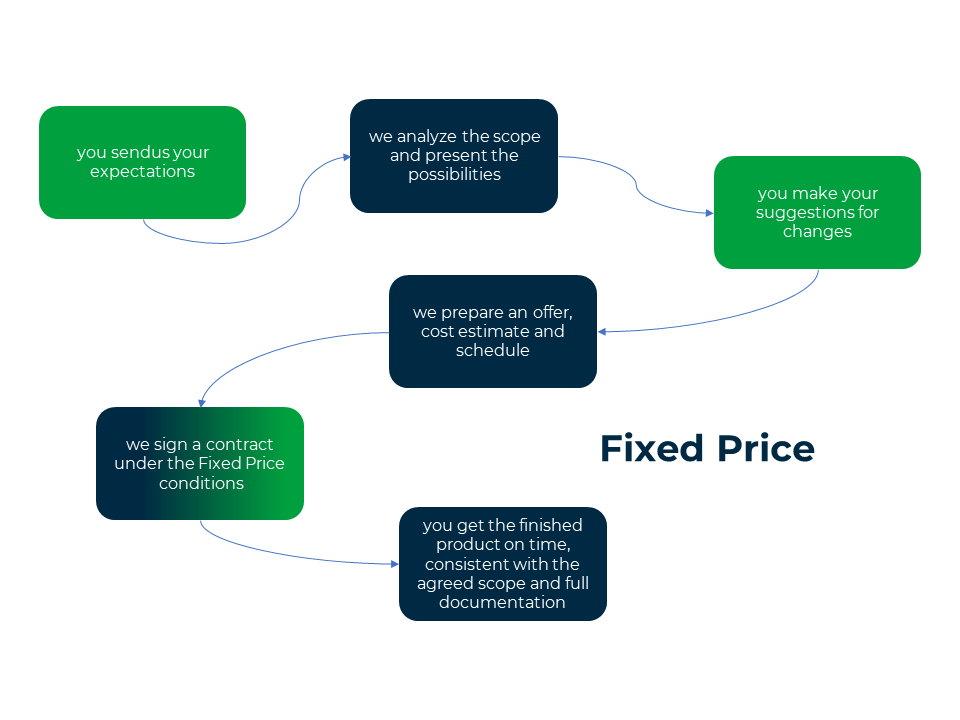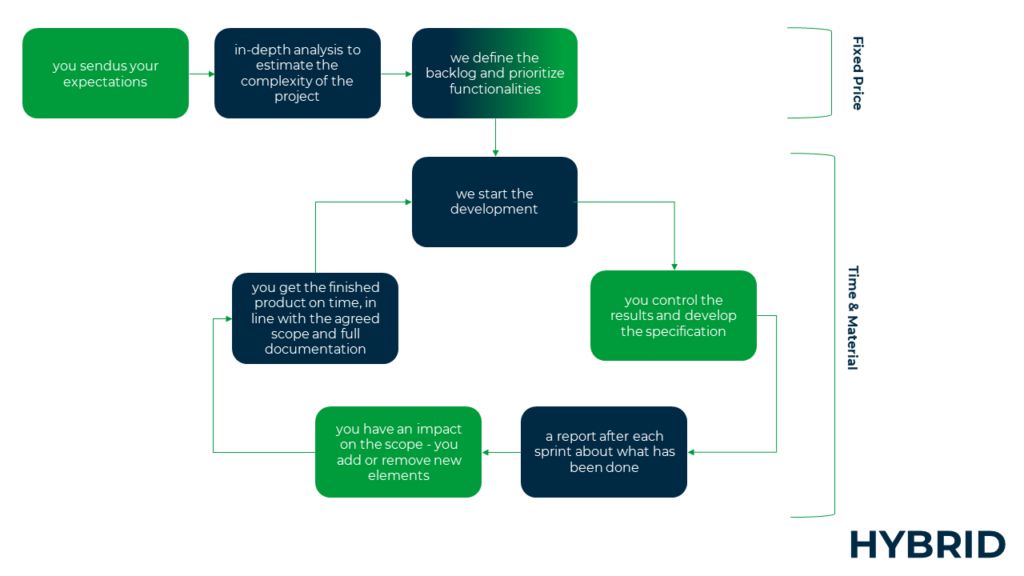
TABLE OF CONTENTS:
The answer to this question is never simple. Read and find out:
When you decide to create or develop custom software, or accelerate its testing, your resources may prove insufficient to do it on your own. That’s why you decide to use an external company.
Choosing the right supplier takes time and you consider many factors, such as:
However, at some point, it becomes crucial for you to decide in what way are going to pay for the provided service.
To begin with, a few words on the billing models used by software companies, based on the example of Solwit. It is important to know both the Time and Materials and Fix Price meanings.
Costs
Let’s start with a “pure” Fixed Price definition: it is a procurement mode, the objective of which is to deliver products that meet the quantity and quality requirements.
A clear advantage of the approach is that you know the total cost of the project in advance, – on the condition that you are clear and consistent regarding the requirements. The software house takes the responsibility for the scope and the deadline, limiting the flexibility in the case of any changes cropping up. It does not mean, however, that modifications cannot be made to the Fixed Price project. They can be introduced via a Change Request, which will be priced separately and implemented outside of the original schedule and budget.
Is Fixed Price the most beneficial billing model and will you pay the lowest possible price for it?
Much depends on the complexity of your project. If the project is complex and you want a fixed price, be prepared that the supplier will include a buffer to cover any additional costs that may arise as a result of unexpected circumstances or complications during the development.
It may happen that you will find defining all project requirements at the beginning of cooperation difficult. Adding new features at a later time may force the supplier to reduce the specification, for the price to remain at the original level. So, it comes down to a “quid pro quo” situation, which is never comfortable neither for you as a customer nor for the supplier who wants to deliver the result you expect. Negotiations consume your time and the whole thing becomes unnecessarily emotional.
When to use Fixed Price?
Fixed Price will be perfect when you know exactly what you want from the very beginning. You have clear requirements, precise specifications and a deadline.

Benefits:
Disadvantages:
Choose it when the project assumes:

Costs
We should start with Time and Materials basis. Let’s have a look at the T&M meaning and what is a time and material contract. In this model, billing is carried out at the pre-set hourly rates of each member of the development team (based on the time and materials pricing), allowing you to flexibly change the pace of implementation and control the cost of the project. In this typically agile approach, work takes place in sprints. After each sprint, you can evaluate the effect of the work and modify the initial project assumptions on the fly.
If you choose the Time and Materials contract, you settle the accounts monthly, or in other periods agreed to before the start of work, depending on the number of hours the development team spends on your project and what materials are used (dedicated licenses, hardware, etc.).
Specification and time to delivery
The greatest value of T&M contracts is that you don’t need to know all the assumptions at the beginning. They can be added in the process. Most importantly, work on the project can start immediately because there is no waiting for the full specs documentation.
Involvement
Time and Materials contract will require more commitment from you. It is you who controls the course of work and verifies the effects. You should also have the appropriate knowledge to verify the quality of the sprints and their results.
Cooperation process

T&M works best when you want to immediately start implementing a complex and long-term project, or you already have a development team but need additional resources. This will give you great flexibility in adjusting the project to your evolving expectations. Although it may seem more expensive, in this case the costs of a T&M project will be lower than that of the Fixed Price model. A project settled according to the T&M model may be shorter and much easier to manage, because everything can be modified on the fly.
Are you curious about what types of projects can be done in this model? The development project for railway safety systems Solwit performed some time ago may prove a good example.
Choose it when you need:

Benefits:
Disadvantages:
You don’t always have to choose It may happen that the best method is a mix of solutions – the hybrid model.
The driving force behind this solution is the fact that we focus on the business effect as a result of the project implementation, regardless of the initial assumptions. The analysis becomes the framework of the project and not the one true source of knowledge. You can influence the shape of the project at any time.
We assume that a rigid T&M or Fixed Price may not meet your expectations. Therefore, after the initial conversation about the project idea, we choose the elements from both models that best suit your situation.
The starting point is the analysis, which we usually perform with the client in the Product Design Sprint formula.
Our experience shows that the client usually knows what they want to achieve but need support in determining the path to reach the goal. We help to set the main project assumptions and together with the client define the detailed scope of work. Based on the analysis, we estimate the workload for individual functionalities, which is the perfect time to decide which model will be used for the next stages of the project.
We have already defined the risks, thanks to the preparatory phase, and we can remove the buffer for unforeseen circumstances, which is usually the reason for the higher cost of the Fixed Price model.
An example of the hybrid model is the case of performing the design phase in the T&M mode, for the reason of its flexibility, and carrying out the development in the Fixed Price formula.
The biggest advantage of the hybrid approach is that you can freely combine billing models, depending on the stage, type and specificity of your project.

| FIXED PRICE | TIME AND MATERIALS | HYBRID | |
| Budget | When you have a tight budget. | When your budget is flexible. | When you want a fixed price, but allow additional costs. |
| Billing model | You pay at the end of the project or in stages. | For working-hours. | To be agreed. |
| Scope | You have a strictly defined scope of the project and each change is priced individually. | The scope is pre-determined and modified on the fly. | We set the scope and specification together. |
| Schedule | The schedule is fixed and cannot be changed. | The duration depends on the scope of work. | We create the schedule together in the preparatory phase. |
| Commitment | You don’t have much time and only want to be present at the beginning and end of the project. | You participate in every stage of the project, monitor the effects, control the scope and budget. | The level of your commitment depends on you. |
| Project start | You accept that the start of the project is possible only after the functional analysis. | The project starts immediately. | Immediately, as soon as we precisely define the assumptions. |
| Documentation | You receive the documentation at the end of the project. | Documentation is created continously, after each sprint. | The decision about documentation is yours. We recommend what we see as the best choice depending on the project type. |
Our experience shows that clients with a fixed budget (are you one of them?) tend to choose the Fixed Price solution, even if the project compliant with the requirements would cost more. They want a guarantee that they will not exceed their budget.
Time and Materials will be chosen more often by those who have their own resources and only need us to help them achieve their goals.
In the turbulent business environment, the scope and functionalities of the project may change dynamically. The original expectations for the final product change to better meet the needs of the market. Technology is changing as well, so you can flexibly use the possibilities it offers. If you are creating an innovative product, the iterative approach is essential to reach its full value. This is exactly what the Time and Materials and Hybrid modes give.
Analyze your project, think about whether you want to take an active part in it. Consider if you have the ability to do so. It is also worth consulting the supplier, as they will give you the best idea of which model will work for your project. Now you know what to expect, depending on the model you are recommended.
